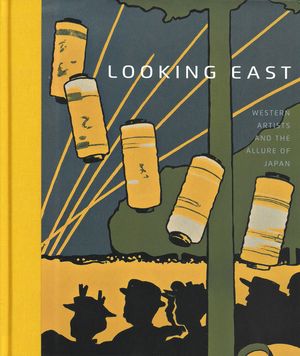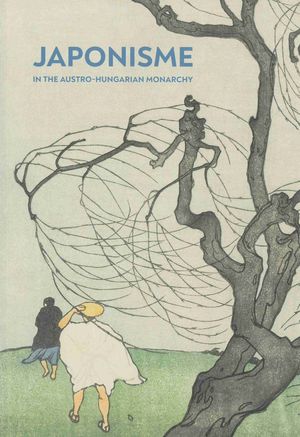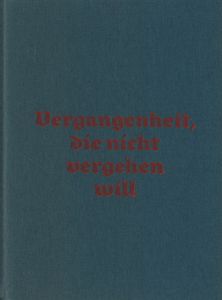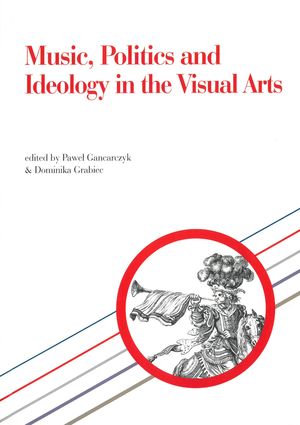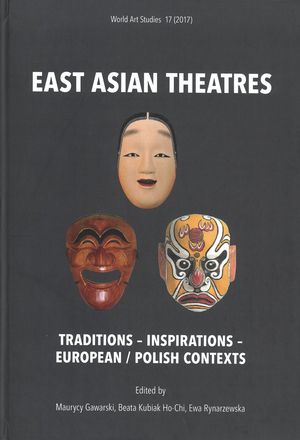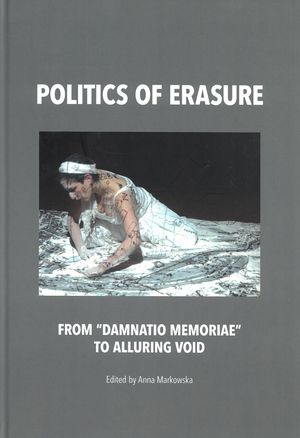Bodor Kata (1978- ). A chronological list of Japanese art-related exhibitions in the Austro-Hungarian Monarchy
(1)
Bodor Kata (1978- ). The mixture of Eastern and Western styles of printmaking in the Austro-Hungarian Monarchy as seen through a characteristic example
(1)
Bojarska Katarzyna (1981- ). Spectrality and the possibility of seeing (loss). Photography against the referentiality of history
(1)
Burnham Helen (1974- )
(1)
Chudzikowska Monika. Chinese Play given in the Chinese Manner
(1)
Deja Katarzyna (1987- ). Józef Jankowski's play Kesa as an example of transculturality in Polish modernism
(1)
Denes Mirjam. An Austro-Hungarian expedition to Japan
(1)
Denes Mirjam. The phenomenon and theme of Japan on the theatrical stages of the Austro-Hungarian Monarchy in three acts
(1)
Denes Mirjam. The treaty od friendship commerce and navigation between Japan and the Austro-Hungarian Monarchy 1869
(1)
Dynes Wayne R. (1934- )
(1)
Eysymontt Rafał (1959- ). The town as a palimpsest. Erasing and recovering the medieval town
(1)
Fajcsak Gyorgyi. Austria exponens invitat orbis universum: the East Asia and Oriental art at the Vienna Weltausstellung 1873
(1)
Farkas Maria Ildikó (1964- ). Imperial identity and national identities as impacted by Japonisme in the Austro-Hungarian Monarchy
(1)
Filipczyk-Topolnicka Joanna (1969- ). Fine arts in the context of the degermanization in the region of Opolian Silesia after 1945
(1)
Foldi Eszter. Japanese-style colour woodcutes in the Austro-Hungarian Monarchy 1902-1914
(1)
Fujii-Karpoluk Yoko. Revived no dramas: issues and perspective
(1)
Furmanik-Kowalska Magdalena. Chinese opera (xiqu) as a significant element of contemporary artwork
(1)
Gancarczyk Paweł (1970- )
(1)
Gawarski Maurycy. Chinese opera theatrical poster in Beijing in the first half of the twentieth century
(1)
Gawarski Maurycy. List of Polish publications on Chinese theatre since the beginning of the twentieth century
(1)
Gawarski Maurycy. Polish research on Chinese theatre since the beginning of the twentieth century to the present day
(1)
Gorlich Aleksandra (1981- ). Kaoyo Gozen and attendants - realtionships between the costumes of the kabuki actors of the Kanadehon Chushingura play and their woodblock-print illustrations
(1)
Grabiec Dominika (muzykologia)
(1)
Gradinaru Camelia. Visual tyranny as autopoiesis
(1)
Gradowski Mariusz. Polish Hair
(1)
Gray Basil (1904-1989)
(1)
Gut Anna (1984- ). The condemnation of memory in the modern epitaphs of Central Pomerania
(1)
Hanova Marketa. Sada Yakko and the reception of Japanese theatre in the context of Japonisme in the Czech lands
(1)
Hibino Kei (1967- ). Making comedy naturalised and vulgar: the theatre of Soganoya Goro the Japanese King of Kigeki
(1)
Hirsch Mary E. (1958- ). What does Chinese Shadow Theatre tell us?
(1)
Ilnicka Zuzanna. Gerhard Richter’s failing memory. The October 18 1977 and the need to allow doubt
(1)
Ilnicki Rafał (1984- ). Digital Lethe of transhumanism: weak mind uploading as erasure of individual and collective memory
(1)
Inoue Takashi. Particularity and new possibilities of Mishima's dramas
(1)
Jarosz Andrzej (1971-2019). The absent ones – placing the post-war Wrocław painting in the context of Polish art
(1)
Jedlińska Eleonora (1954- ). A nook at Wolborska Street or expunged remains of Jewish culture in Łódź
(1)
Katalinić Vjera (1955- ). Visualisation of the national in nineteenth-century opera in Zagreb
(1)
Kaulbach Barbara M. (1950- ). Chinese theatre at the crossroads - Ouyang Yuqian and the West
(1)
Kiss Sandor. Japonisme exported from Japan
(1)
Klimczak-Dobrzaniecka Alicja. Erasure. Memory Exercises
(1)
Kluczewska-Wójcik Agnieszka (1960- )
(1)
Kluczewska-Wójcik Agnieszka (1960- ). Yellow peril bright future: visual arts and the changing perception of Japan in West and East Europe
(1)
Kluczewska-Wójcik Agnieszka. Go East: Orientalism and Japonisme in the Austro-Hungarian Monarchy
(1)
Komatsu Hiroshi. Similarity and difference
(1)
Krzyżanowska Małgorzata Ksenia. Nothing is getting as old as modernity – i.e. why the trend for Nine Graphic Artists Group has passed
(1)
Kubala Agata. Damnatio memoriae and Roman imperial art
(1)
Kubiak Ho-Chi Beata (1958- )
(1)
Kubiak Ho-Chi Beata (1958- ). Tragedy and the tragic in the Japanese puppet theatre
(1)
Kłos Agnieszka. The disappearing memory of Birkenau. A story of the power of nature
(1)
Leca Radu. Women as active agents of Japonisme in the Dual Monarchy
(1)
Lecińska-Ruchniewicz Monika. Entering the world of dreams
(1)
Lee Insoo. Intercultural call from the Third World: Jaram Lee's Brecht pansori Sacheonga
(1)
Lee Sang Woo. Between art and scandal: the actresses of Towolhoe and the gender politics of scandal
(1)
Li Wei. On female consciousness in contemporary xiqu in China
(1)
Li Ying. Theatre and politics in China (PRC) in the recent years
(1)
Lis Marianna. Wacinwa
(1)
Malinowski Jerzy (1950- )
(1)
Markowska Anna (1962- ). Conspicuously absent Jews alien environments: Polish artists Mirosław Bałka and Rafał Jakubowicz on the Holocaust
(1)
Markowska Anna (1962- ). Spolia Tannenberg-Denkmal czyli tożsamość w kontekście przemocy
(1)
Markowska Anna (1962- ). Tannenberg-Nationaldenkmal: spolia or identity in the context of violence
(1)
Mond-Kozłowska Wiesna. Western aesthetic needs turning to no theatre
(1)
Morawiecka Maria Magdalena (1986- ). Terra incognita. On cartographic silence on old maps (Middle Ages and the beginning of the Early Modern Period)
(1)
Nadali Davide (1977- ). Looking at music: the representation of the ancient Near East between fiction and reality in the age of orientalism
(1)
Narusyte Agne (1970- ). Memory of erased time in The Soldier’s Diary by Lithuanian artist Gintaras Zinkevicius
(1)
Niemira Konrad (1989- ). Isolation / Erasure / Oblivion. An artwork in Marcel Proust’s A la recherche de temps perdu
(1)
Nieszczerzewska Małgorzata. Erasure of time. Photographs of abandoned places
(1)
Nordeborg Martin (1961- ). Translated Western plays as a symbol of modernity in Japan of the 1920s
(1)
Paek Sung-suk (1967- ). Imagined geographies of city space in 1942: Seoul Shanghai Warsaw Tokyo
(1)
Palęcka Alicja. Visualizing the other: ethnographic film as thick description
(1)
Pantzer Peter (1942- ). Artists from the Austro-Hungarian Monarchy in Japan 1869-1918
(1)
Park Chan E. (1951- ). Inter-cultural discourse on p'ansori: the theatre of the imagination
(1)
Popa Lucia. Removing Romania: the Western art world colonized by the East
(1)
Rewers Ewa (1952- ). Arts of oblivion
(1)
Rewers Ewa (1952- ). Sztuki zapomnienia
(1)
Robinson Basil William (1912-2005)
(1)
Rodowicz-Czechowska Jadwiga Maria (1954- ). Farewell to Professor Zbigniew Osiński
(1)
Rodowicz-Czechowska Jadwiga Maria (1954- ). Tadeusz Kantor in the theatrical life of Japan 1979-2015
(1)
Rutkowska Iga. Need to laugh - comic elements in Japanese performing arts - on the example of kabuki theatre
(1)
Rutkowska Iga. Research on the reception of the theatre of East Asia in Poland: from the example of Zbigniew Osiński's work
(1)
Rynarzewska Ewa. From village comedian to celebrity: metamorphosis of the Korean actor in the years of Japanese occupation (1910-1945)
(1)
Santarelli Cristina. Soft anti-Turkish propaganda in some seventeenth-century Savoy court celebrations
(1)
Scheflan-Katzav Hadara (1963- ). Re-representation – critical art and the return of the repressed
(1)
Sikora Patrycja (1978- ). Erasure. Memory Exercises
(1)
Sikora-Sabat Anna. Romantic creation and socialist erasure: representation of Vincent van Gogh in the printed media of the People’s Republic of Poland
(1)
Sinicka Agnieszka. Wilhem Sasnal’s photophobia
(1)
Smolińska Marta (1975- ). Jan Berdyszak. Between paradigms of modernity or nowhere? Subjective remarks across the post-war history of art in Poland
(1)
Soczyńska Agata. Marek Oberlander – a painter undesired by the time
(1)
Speare Jed. Washing up memories: some strategies of Milan Kohout’s performance activism
(1)
Spławski Piotr. Hilarity and the coffeehouse: cafe culture humor and Japan
(1)
Spławski Piotr. The impact of Japanese art collections on the education of art and design in the Austro-Hungarian Monarchy
(1)

